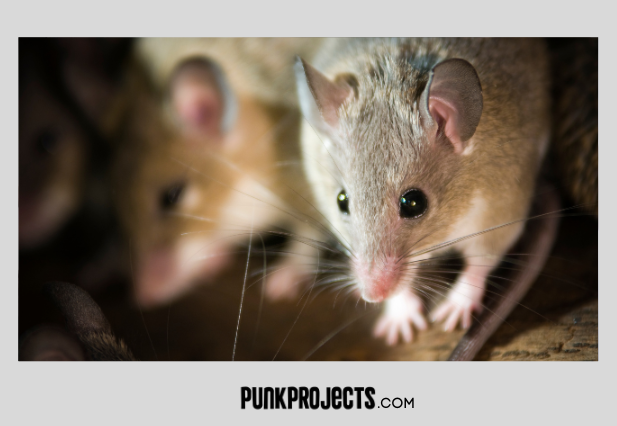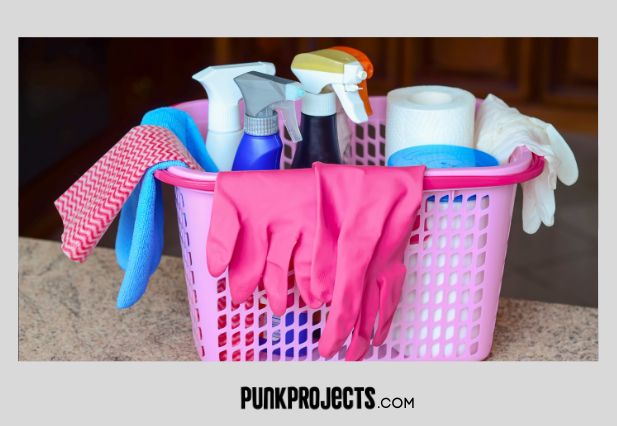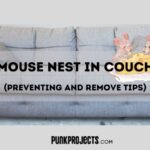Mice in couches can be a surprise. But it’s not that uncommon. This article will give information to avoid mouse nest in couch. It’ll explain why this happens and provide solutions to the problem.
This can lead to several problems. The obvious ones are dirt and germs from their droppings and urine. Plus, they can chew on materials and damage furniture.
According to Pest Control Technology Magazine, 45% of rodent infestations involve nesting in upholstered furniture. So, it’s important to be aware and take action quickly.
Identifying the Problem

Mouse nests can be a big concern. Look for chewed fabric, scattered nesting materials, and a musty smell to identify the problem. Act fast to stop further damage and possible health risks.
Where did the mouse come from? They look for warm, enclosed spaces – like our couches. Knowing their behavior helps figure out how to deal with them.
Try humane traps or hire a professional exterminator. Check other furniture and areas for more signs of mice. Seal any cracks or holes that they could use to get in.
A friend of mine found a family of mice in their sofa – a reminder to act fast to get rid of nesting problems.
Assessing the Damage
Assessing the Extent of Damage
To evaluate the scale of harm caused by the mouse nest in the couch, the following table provides an organized overview of the actual damage.
| Area | Damage |
|---|---|
| Cushions | Chewed fabric, possible nesting material |
| Frame | Scratches, gnawing marks |
| Springs | Chewed wires, potential loss of structural integrity |
| Upholstery | Stains, soiling, potential contamination |
| Other | Presence of droppings, urine odor |
Apart from the visible damage, it is crucial to consider potential health hazards associated with the mouse nest, such as the spread of diseases or allergens.
Throughout history, instances of mice nesting in furniture have been reported globally. While it is a common issue, it should not be overlooked due to the health risks and potential damage it can cause to furniture. Looking for a cozy home? Just check your couch – you might find a mouse nest that’s way more inviting than you expected.
Checking for Nest Material
Inspecting nest material is super important when assessing damage. It can provide key info about animals in a certain area. Here’s a 3-step guide to checking nest material:
- Check the surroundings – look for twigs, leaves, feathers and other small objects animals use to build nests.
- Inspect hidden areas – like tree cavities, abandoned buildings, or any other spot animals might use for shelter.
- Analyze the materials – take note of the type and condition of the nest material. This can help identify the species and tell you more about their nesting habits.
For a complete understanding, be sure to check potential areas where nests could be found. Nest material is valuable evidence for ecological studies.
Examining the Couch for Signs of Infestation
When inspecting a couch for infestation, look out for:
- Live or dead insects – like bed bugs, fleas, or carpet beetles.
- Stains and discoloration – these may be from bug droppings or urine.
- Egg casings – small, oval-shaped casings in crevices or seams.
- Shed exoskeletons – transparent shells left behind by growing bugs.
- Musty odors – could be from mold or cockroaches.
Each type of pest infestation may have specific indicators, so it’s best to consult a professional.
Did you know? In Ancient Egypt, infestations were seen as a symbol of wealth and luxury. Cleopatra’s throne was known to be plagued by fleas and lice. Now, thanks to modern pest control, we can effectively tackle infestations.
Steps to Remove the Mouse Nest

Removing a mouse nest from a couch requires specific steps to ensure a successful and effective removal process. Follow the guidelines below to address this issue:
- Identify the Nest:
- Inspect the couch thoroughly, looking for signs of mouse activity such as droppings, chewed fabric, or foul odors.
- Consider using a flashlight to search in dark corners or behind cushions.
- Look for nesting materials like shredded fabric, paper, or insulation.
- Safely Remove the Nest:
- Put on protective gloves to avoid contact with any potentially harmful substances.
- Carefully remove the nest from the couch, ensuring that no mice are present.
- Place the nest in a sealed bag to prevent escape or further infestation.
- Dispose of the bag in an appropriate manner, considering local regulations.
- Clean and Disinfect the Couch:
- Vacuum the couch thoroughly, paying special attention to crevices, seams, and other hiding spots.
- Use a disinfectant spray or solution to sanitize the entire couch surface, including cushions and fabric.
- If necessary, wash removable covers or cushions using hot water and detergent.
- Allow the couch to dry completely before using it again.
Important Details:
- It is crucial to act promptly when discovering a mouse nest in a couch to prevent further infestation and potential health risks.
- Regularly inspect your home for any potential entry points to prevent mice from returning.
- Utilize mouse traps or consult a professional pest control service if the infestation persists.
Suggestions:
- Keep food sources securely stored in containers that cannot be accessed by mice.
- Seal any gaps or holes in your home’s exterior, such as cracks in the foundation or openings around pipes.
- Trim trees or shrubs near your house to limit easy access for mice.
Understanding the importance of following these steps and taking preventative measures will help to efficiently remove a mouse nest from a couch and minimize the chances of future infestations.
The mouse nest in your couch is a reminder that if you don’t vacuum regularly, nature will find a way to cozy up to you.
Gather the Necessary Tools and Materials

Gathering the right tools and materials is key for removing a mouse nest. Here’s a guide for that:
- Get protective gear such as gloves, a face mask and safety goggles. These will protect you and keep you away from any direct contact with the nest.
- Gather cleaning supplies like disinfectant, a broom and a dustpan. These will help you clean up the area after removing the nest.
- Get a sealable bag or container to store the nest and debris.
Remember a few things:
- Dispose of the nest in an appropriate waste bin.
- Check your home for any signs of mice infestation.
- Before you begin, check for any obstructions such as electrical wires. This will help prevent any accidents.
Begin by Vacuuming the Couch
Get rid of those mouse nests in your couch with this step-by-step guide! Start by vacuuming the affected area with your best vacuum cleaner. This will eliminate any debris or droppings.
Now, onto the process:
- Inspect your couch: Look for signs like fabric, paper, grass, or fur.
- Put on protective gear: Wear gloves and a face mask.
- Remove materials: Use a brush or gloved hand to get rid of nesting materials and droppings.
- Vacuum thoroughly: Cover every inch with an upholstery attachment. Reach into crevices and seams.
- Empty and clean the vacuum: Dispose of the bag outside. Sanitize the vacuum cleaner.
- Wash removable covers: If you have any, launder them in hot water.
Be aware that mice carry diseases like HPS. So be sure to take precautions when dealing with their nests.
Removing the Nest Material
- Put on gloves and a mask to protect yourself.
- Then, place the nest in a sealed plastic bag and throw it away.
- Mix bleach and water, then use it to clean the area where the nest was found.
- Look around to make sure no nests or droppings remain.
- To avoid future infestations, clean and sanitize your home regularly.
- Block any gaps or holes in your home’s foundation.
- Remove food sources that may attract mice, such as unsealed containers or crumbs.
By doing this, you can effectively remove mouse nests and reduce the risk of further infestations.
Disposing of the Nest Properly
Safety first! Protect yourself with gloves and a face mask.
Use a long-handled tool or plastic bag to remove the nest. Make sure none of the contents scatter.
Tie up the nest in a garbage bag and dispose of it according to local waste management guidelines.
Be sure to avoid touching or breathing in particles from the nest. They may contain harmful bacteria or parasites.
Did you know? Mice nests are usually found in hidden spots like attics, crawlspaces, and wall voids.
Preventing Future Infestations

Preventing Future Infestations:
To ensure you never have to deal with another mouse nest in your couch, follow this 6-step guide:
- Seal any potential entry points: Inspect your home for gaps or cracks that mice can crawl through, and seal them with caulk or steel wool.
- Keep a clean environment: Eliminate any food sources that can attract mice, such as crumbs or spilled pet food. Store food in secure containers.
- Maintain proper sanitation: Regularly clean your home, particularly areas like the kitchen and dining area, to remove any potential nesting material or attractants.
- Trim vegetation around your home: Mice often use overgrown plants and shrubs as cover to enter your property. Keep vegetation well-maintained to discourage them.
- Use mouse repellents: Consider using natural deterrents like peppermint oil or commercial mouse repellents around your home’s perimeter and entry points.
- Set traps or install bait stations: In case you spot any signs of mouse activity, place traps or bait stations strategically to catch and remove any remaining rodents.
Remember, prevention is key. By implementing these steps, you can significantly reduce the risk of future infestations and keep your home mouse-free.
In addition to these preventive measures, it’s important to note that mice are known carriers of various diseases, including hantavirus. Taking proactive steps to prevent mouse infestations can help protect the health and well-being of your family.
True fact: According to the National Pest Management Association, mice can squeeze through holes as small as a dime, making it essential to seal even the tiniest openings in your home.
Seal any Entry Points: Just in case you don’t want your couch turning into the set of ‘Mouse Cribs’ – the latest reality show for fashionable rodents.
Seal any Entry Points
Block off entry points for pests to keep them out of your home! Here’s a 4-step guide to help you:
- Assess and Identify. Inspect your property to find out where pests can get in. Check for cracks, gaps, damaged vents/screens, and openings in walls/ceilings.
- Seal Cracks and Gaps. Use a sealant like caulk or foam to fill all holes. It should be tough and weather-resistant.
- Reinforce Windows and Doors. Install weatherstripping around windows/doors. It’ll seal gaps & improve energy efficiency.
- Secure Vents and Screens. Check vents/screens for damage or holes. Repair or replace if necessary.
Don’t forget the other steps in pest prevention: keep clean, remove food sources, and inspect your property often.
Pro Tip: Pay special attention to areas where utilities enter your home (e.g. pipes, cables, wires). These can be easy access for pests if not sealed.
Store Food Properly
Properly storing food is key to preventing infestations. Here are 4 steps to keep your food fresh and pest-free:
- Use airtight containers. Put opened packages of food, such as cereal, grains, and flour, in airtight containers.
- Organize your pantry. Arrange it neatly, so you can easily access items. Check expiration dates to use up older products first.
- Clean spills quickly. Wipe up spills and crumbs right away. Wipe shelves regularly and chuck out expired or spoiled items.
- Store perishable foods correctly. Keep things like fruits, vegetables, and meat chilled at the right temperature to avoid spoiling and deter pests.
Plus, seal any cracks and gaps in your kitchen to further stop insects and rodents from entering your home.
By storing food the right way, you can minimize pest risk and extend the shelf life of your groceries. Don’t let pests ruin your meals – take action now!
Regularly Clean and Inspect the Area
Cleaning and inspecting your area regularly is vital to avoiding infestations. This proactive approach helps you spot and fix any issues before they turn into major hassles. To clean and inspect your area, here are 6 easy steps:
- Tidy up the space, taking away any mess. Clutter gives pests shelter, so keeping things tidy is essential.
- Clean walls, surfaces, and floors using the right products. Don’t forget corners and crevices which are often forgotten.
- Check all entry points (windows, doors, vents etc.) for openings that pests can use. Close holes with caulk or weatherstripping.
- Look for any signs of pests, such as droppings or chewed wires. If you spot any, contact a pest control pro straight away.
- Store food properly in sealed containers to keep pests away. Empty and clean trash bins often to deny pests food.
- Schedule maintenance for equipment and appliances that could attract pests if not kept in good condition.
Monitor your area regularly for any new changes or infestations. Stay alert and get help from experts when needed to keep your space pest-free. Don’t let pests take over! By cleaning and inspecting regularly, you can protect your living or working space from damage caused by pests. Act now!
Conclusion
Unveiling the secrets of mouse nests in couches, we’ve found a range of astonishing facts. We discovered the nesting habits of mice and the dangers they can bring to our homes. We learned that the damage caused by these unwelcome guests is serious, so decisive action must be taken.
It’s not just a nuisance, it’s a health hazard too: mouse nests can be a breeding ground for illnesses and allergies, putting grown-ups and kids in danger.
Homeowners should take immediate action upon spotting signs of a mouse infestation. Professional help or effective tactics to eliminate them should be sought. In addition, preventive measures such as regular cleaning and blocking entry points will make our homes safer.
We can’t afford to be careless. Complacency can let pests into the places we least expect. We must take responsibility for our homes, and make sure no corner is left unchecked. Don’t wait until it’s too late – act now!
Frequently Asked Questions
How do I know if there is a mouse nest in my couch?
A mouse nest in your couch can be identified by several signs such as shredded fabric or insulation, small droppings, a distinct musty odor, or sightings of mice entering or exiting the couch.
What should I do if I find a mouse nest in my couch?
If you discover a mouse nest in your couch, it is essential to handle the situation promptly. Remove any nesting materials, droppings, and clean the area thoroughly. Seal any entry points in your home to prevent future infestations, and consider contacting a pest control professional for further assistance
Can a mouse nest in a couch cause health problems?
Yes, a mouse nest in your couch can potentially lead to health issues. Mice can carry diseases, bacteria, and parasites, which can be harmful to humans. Inhaling dust or coming into contact with mouse droppings can result in respiratory problems, allergies, or even transmit certain diseases.
How can I prevent mice from nesting in my couch?
To prevent mice from nesting in your couch, take preventative measures such as keeping your home clean and clutter-free, sealing any potential entry points, storing food in airtight containers, and regularly inspecting your furniture and upholstery for any signs of infestation.
Should I use poison to get rid of mice in my couch?
Using poison to eliminate mice nesting in your couch is generally discouraged. Poison can pose risks to humans and pets if not handled properly. It is best to opt for alternative methods such as trapping, exclusion techniques, or seeking professional help from pest control experts who can provide safe and effective solutions.
How long does it take to get rid of a mouse nest in a couch?
The time required to get rid of a mouse nest in a couch depends on the severity of the infestation and the chosen method of removal. DIY methods may take longer and may not always be effective, while professional pest control services can provide quicker and more reliable solutions.
I am a multi-talented designer and contractor with over 10 years of experience in the field. I have a passion for creating beautiful, innovative spaces that reflect my clients’ needs and styles. My skills include architectural design, interior design, space planning, project management and construction supervision.






